Introduction
This seems to be the season for NAS operating system upgrades. Recently, we took a look at Buffalo’s new OS that powers its new line of TeraStations as well as the latest ReadyNAS OS6 from NETGEAR. Now, as promised in Tim’s review of QNAP’s TS-421, we’ll be taking a look a more in-depth look at QNAP’s QTS 4.0 (tested version was 4.01). I won’t be covering setup – Tim covered that extensively in the setup slideshow gallery on the first page of his review.
Since were we’ll be talking about the new OS’s look and feel, I’ll use a number of galleries to give you a good idea of the features of the new OS. QNAP also provides several introductory videos including this one that provides an overview of the new OS. If you’d like to poke around the new user interface on your own, QNAP conveniently provides an online live demo here.
Overview
QTS 4.0 adds many features not found in earlier versions. As shown in the screenshot above, QTS 4.0 gives you a new, fresh user interface that’s very similar to what you’ll find in the latest Synology DSM4.X OS.
You have multiple desktop spaces and can personalize those spaces with drag and drop icons and icon groupings shortcuts or by using your own wallpaper. Status icons at the top of the screen allow you to view active backup jobs or Anti-Virus scanning jobs. Here’s a gallery to show you some of the features of the new UI.
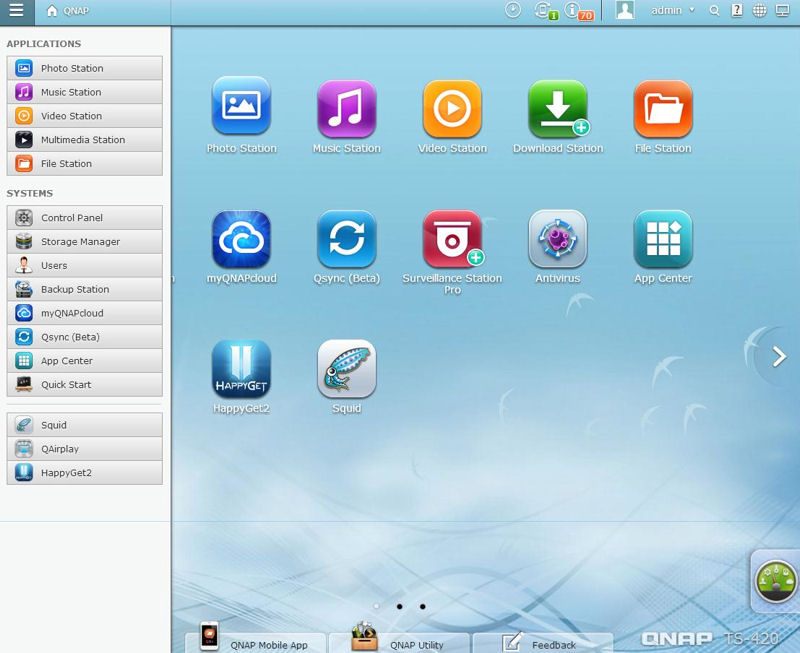
If you click on the three horizontal lines in the upper left corner of the screen, a flyout sub menu appears.
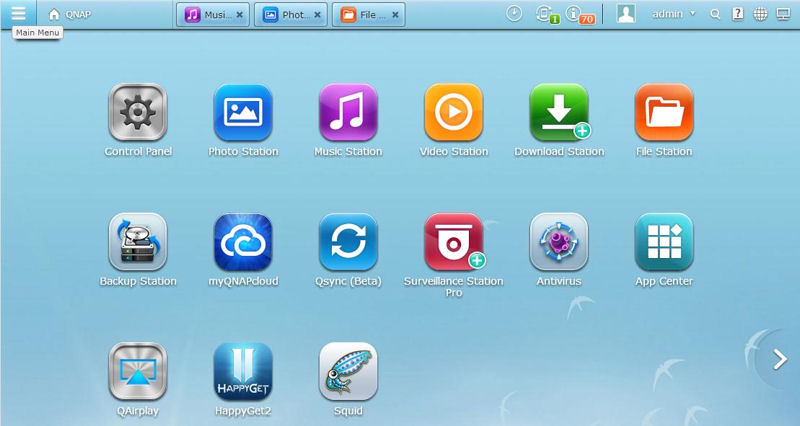
Across the top of the screen, active tasks are shown. Here, the Music, Photo and File stations are open.
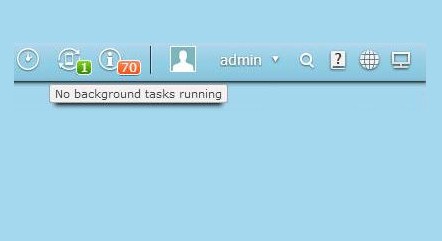
The first circle shows now background tasks running. The second show an attached drive for backups. The "i" shows the number of system notifications.
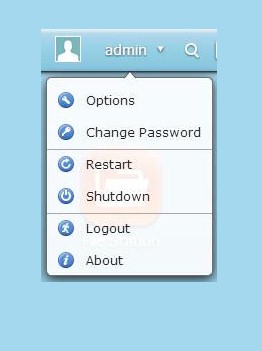
If you click on the people icon, you can change profile info (password, etc.) for the logged in user. Logged in as admin, you can also shutdown or restart the NAS.
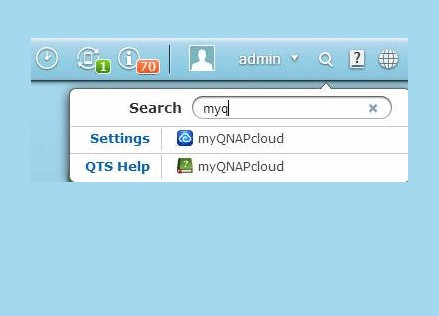
You can search within the QNAP desktop and help
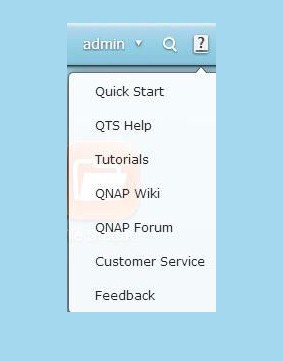
The "?" provides links to various QNAP help resources
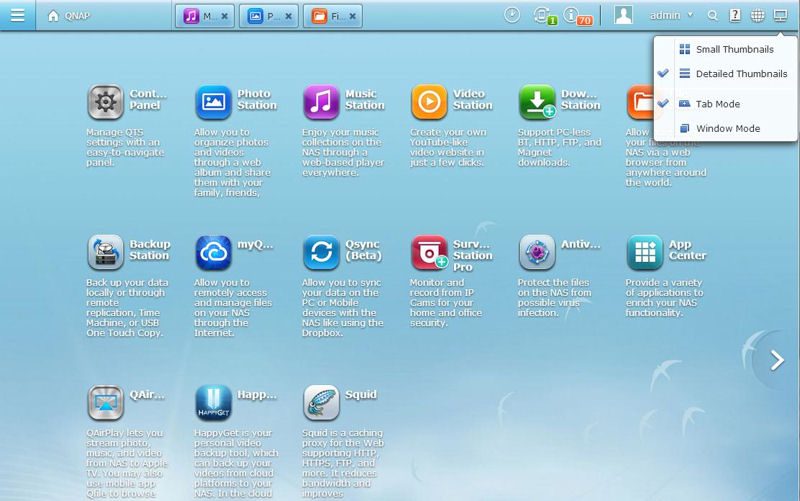
You can change desktop modes or thumbnails. Here, I switched to detailed thumbnails. Tab mode is very handy if you don’t like resizing and moving windows.
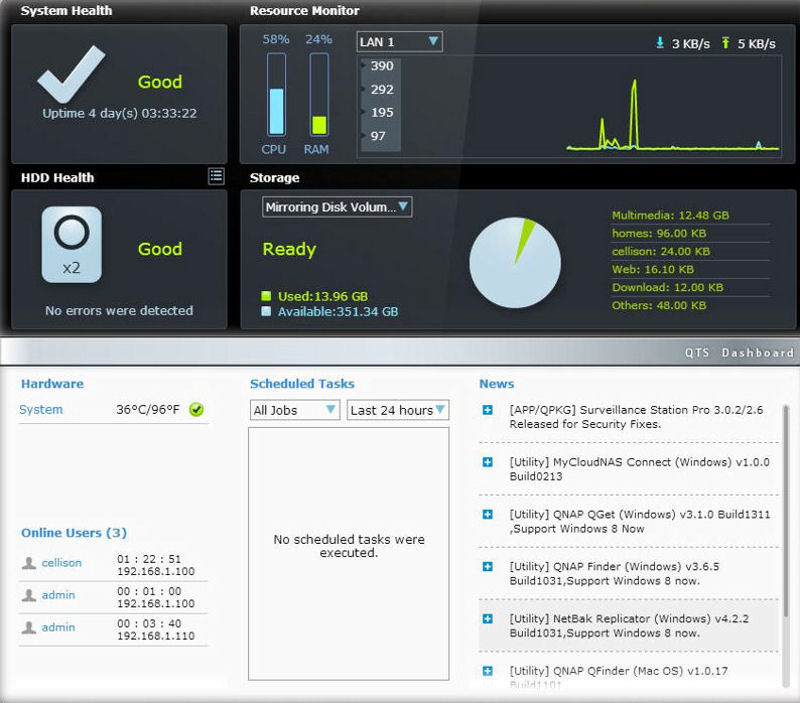
If you click on the dashboard icon, you’ll get an overall summary of your QNAP device
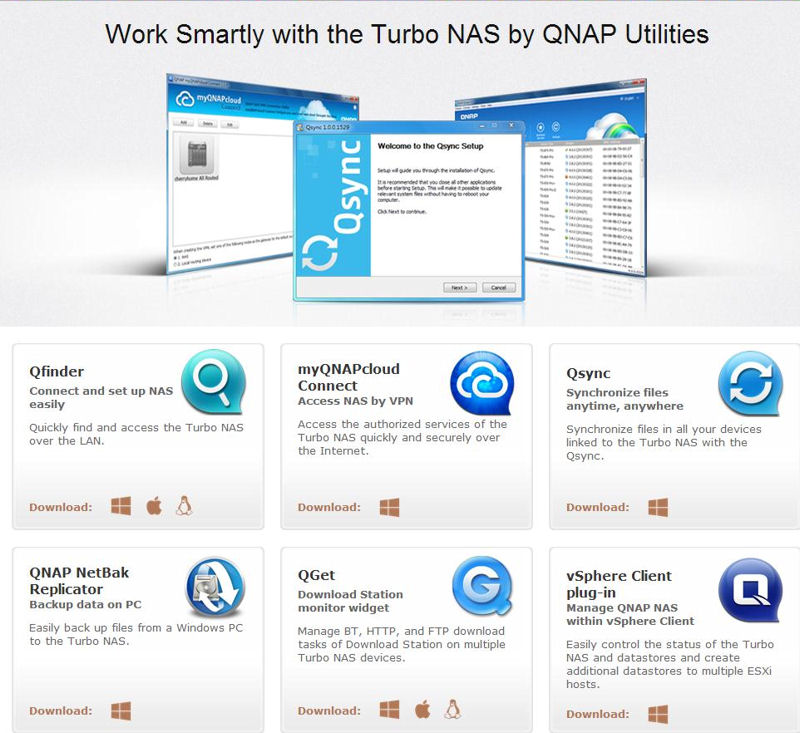
Clicking on this tab at the bottom of the screen takes you to a download page of QNAP utilities that you can install on supported platforms.
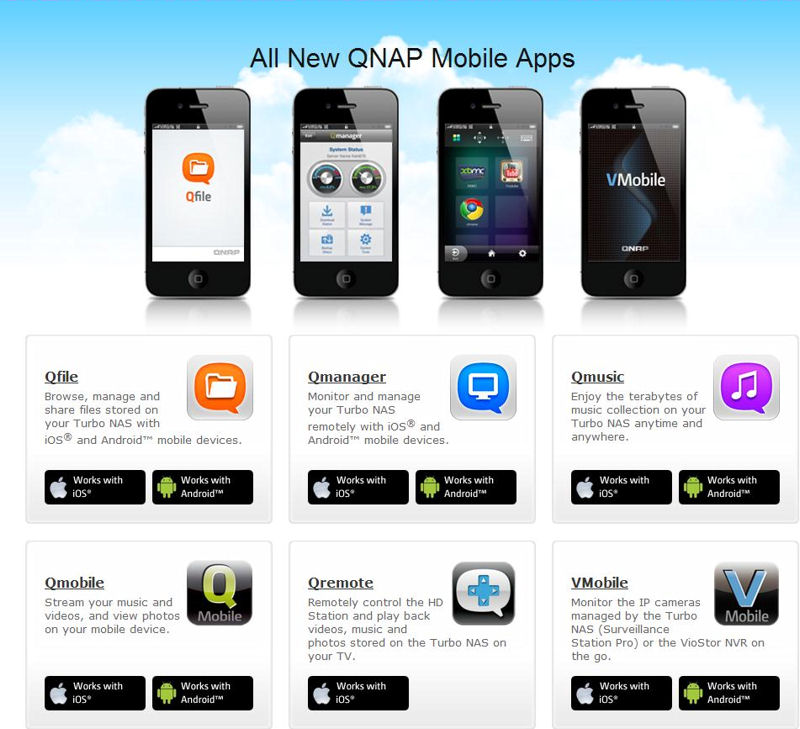
This tab takes you to a page showing QNAP Mobile APPS.
UI Gallery
Control Panel
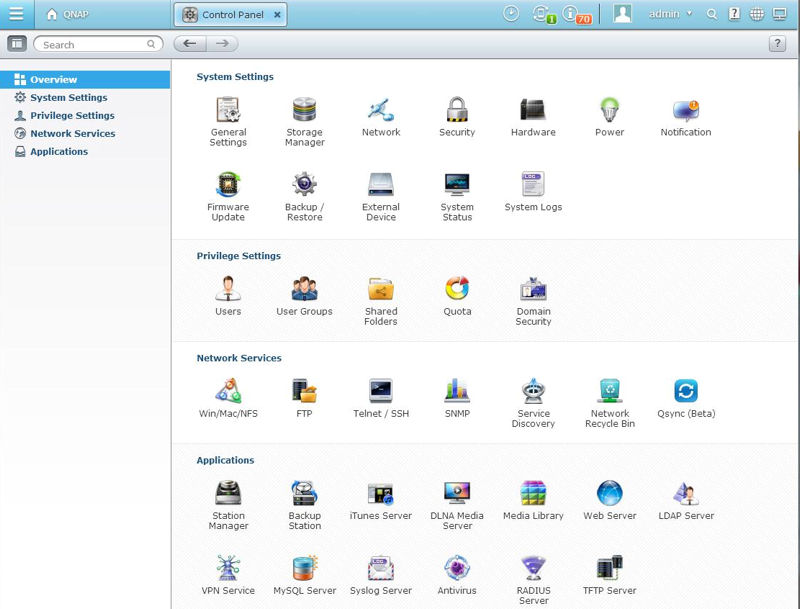
QNAP Control Panel Overview
Configuration of the QNAP NAS is done from the control panel. If you click on the control panel icon on the landing page, you’ll land at this screen. As seen on the left side of the screen, all control panel configuration options are broken down into four categories: System Settings; Privilege Settings; Network Services; and Applications.
I’ll cover many of the major features in the gallery below. If your curiosity is piqued by some of the features I didn’t cover, check out the live demo linked above.

If you click on the three horizontal lines in the upper left corner of the screen, a flyout sub menu appears.

Across the top of the screen, active tasks are shown. Here, the Music, Photo and File stations are open.

The first circle shows now background tasks running. The second show an attached drive for backups. The "i" shows the number of system notifications.

If you click on the people icon, you can change profile info (password, etc.) for the logged in user. Logged in as admin, you can also shutdown or restart the NAS.

You can search within the QNAP desktop and help

The "?" provides links to various QNAP help resources

You can change desktop modes or thumbnails. Here, I switched to detailed thumbnails. Tab mode is very handy if you don’t like resizing and moving windows.

If you click on the dashboard icon, you’ll get an overall summary of your QNAP device

Clicking on this tab at the bottom of the screen takes you to a download page of QNAP utilities that you can install on supported platforms.

This tab takes you to a page showing QNAP Mobile APPS.
Control Panel Gallery
You’ll also note that QNAP has added a number of “Station” applications such as Photo Station, Music Station, Video Station, File Station and Download Station. If you’re thinking those names sound familiar, you’re right. If you search the web for those terms, most likely the search results will reference features in Synology’s products.
To simplify management of all of the “stations”, QNAP has included a Station Manager application that lets you easily configure each of the station from one convenient menu. I’ll touch briefly on several of the “station” features.
Photo Station – Photo Station lets you easily publish your photos. You can create slideshows and share individual photos or slideshows via email, to selected social media sites, or via a link generated by the QNAP NAS.
Music Station – This supports both personal and shared playlists. You can view your music by genre, artist, song, or browse your private collection or the Media Library folder. Support is built-in for TuneIn Radio which has over 70,000 stations and podcasts. You share music by dragging and dropping selections into the share box on the right hand side of the screen. You can share individual songs or entire albums using the same sharing UI that we saw in the Photo Station.
File Station – This replaces the previous Web File Manager. From the File Station, you can share files or folders via download links. You have a full range of file manipulation capabilities including copy, move, upload, download rename delete, open and play. You can also zip files File Station displays local computer files for uploads and downloads. Thumbnails are created for quick previews. For movies, File Station will let you add them to a queue for transcoding (still in beta) to formats compatible with smartphones and mobile devices.
Transcoding is very CPU intensive, so you’ll want to plan transcoding when the NAS won’t be terribly busy. You may also want to avoid the feature entirely on Marvell-powered models. I saw CPU spikes in the 90% range during transcoding on the Marvell-based TS-420 I used for this review.
Video Station – If you’ve always wanted to publish video from your own server, Video Station is the answer for you. You can publish your videos via email or with links. You can select videos to feature (Editor’s picks), visitors can comment on videos, and the Video Station keeps “YouTube-like” statistics on videos viewed.
The video station uses a different sharing UI than the Photo and Music stations. When you click on the share icon, it generates internal and external links as wells as HTML code for embedding into a web page based on the corresponding IP addresses, i.e., your public IP address and the internal IP address for your NAS. Unfortunately, it doesn’t automatically populate the link with your myQNAPcloud account. You can, however, manually change the external IP address to your myqnapcloud.com. I’ll cover myQNAPcloud in the next section.
Below is a gallery that contains screenshots of each of the “Stations” that I described.

If you click on the three horizontal lines in the upper left corner of the screen, a flyout sub menu appears.

Across the top of the screen, active tasks are shown. Here, the Music, Photo and File stations are open.

The first circle shows now background tasks running. The second show an attached drive for backups. The "i" shows the number of system notifications.

If you click on the people icon, you can change profile info (password, etc.) for the logged in user. Logged in as admin, you can also shutdown or restart the NAS.

You can search within the QNAP desktop and help

The "?" provides links to various QNAP help resources

You can change desktop modes or thumbnails. Here, I switched to detailed thumbnails. Tab mode is very handy if you don’t like resizing and moving windows.

If you click on the dashboard icon, you’ll get an overall summary of your QNAP device

Clicking on this tab at the bottom of the screen takes you to a download page of QNAP utilities that you can install on supported platforms.

This tab takes you to a page showing QNAP Mobile APPS.
Station Gallery
myQNAPcloud
myQNAPcloud is a service that provides remote access to your QNAP NAS, replacing the previous MyCloudNAS service. To use myQNAPcloud, you need to create an account and register your device. If your router supports UPnP and you have it enabled, the myQNAPcloud service will automatically open the ports needed for remote access.
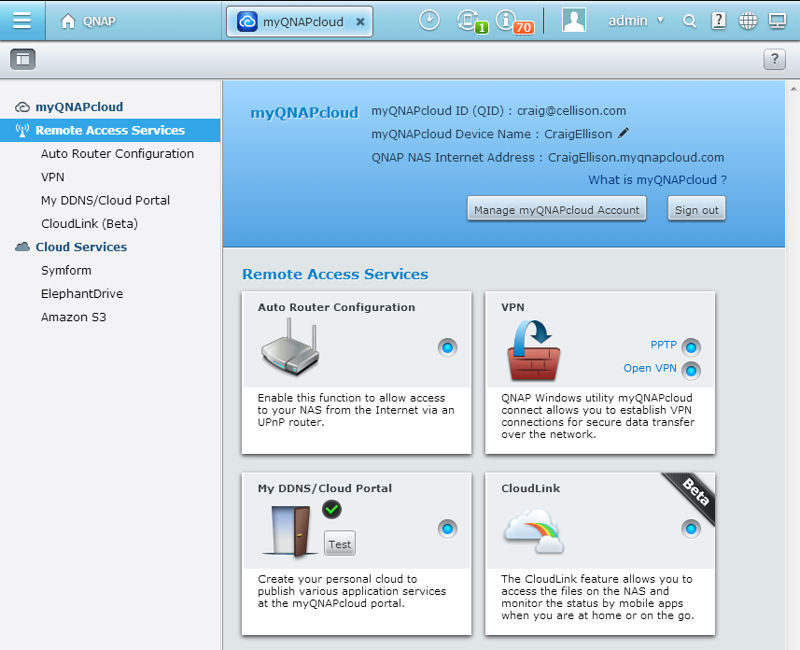
myQNAPcloud Landing Page
An auto configuration wizard will help you through the initial setup for your remote access services. I tested this with UPnP enabled on my router and then checked the portmap on my NETGEAR WNDR3800. The ports specified for the services I enabled were properly opened on the router.

If you click on the three horizontal lines in the upper left corner of the screen, a flyout sub menu appears.

Across the top of the screen, active tasks are shown. Here, the Music, Photo and File stations are open.

The first circle shows now background tasks running. The second show an attached drive for backups. The "i" shows the number of system notifications.

If you click on the people icon, you can change profile info (password, etc.) for the logged in user. Logged in as admin, you can also shutdown or restart the NAS.

You can search within the QNAP desktop and help

The "?" provides links to various QNAP help resources

You can change desktop modes or thumbnails. Here, I switched to detailed thumbnails. Tab mode is very handy if you don’t like resizing and moving windows.

If you click on the dashboard icon, you’ll get an overall summary of your QNAP device

Clicking on this tab at the bottom of the screen takes you to a download page of QNAP utilities that you can install on supported platforms.

This tab takes you to a page showing QNAP Mobile APPS.
myQNAPcloud Gallery
After setting up myQNAPcloud, you merely have to enter http://NASNAME.myqnapcloud.com (where NASNAME is the name you used when you registered your NAS with the myQNAPcloud service) into your browser to access your NAS remotely. A secure HTTPS link is also supported, though you will get a certificate warning since your NAS uses a self-signed certificate. When you connect, you’ll land at the same login page as though you were on your local network.
I tested remote access on a remote network using an iPad as well as two Android based devices. All showed the home screen (shown at the top of the review) after logging in remotely.
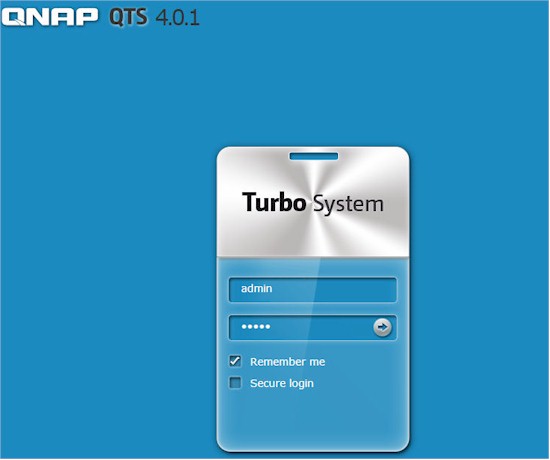
QNAP NAS login page
QNAP also has included a beta version of a service they call CloudLink. Their CloudLink configuration menu says, "It may work even if your router does not support UPnP".
To test CloudLink, I disabled UPnP on my router then checked back to make sure that CloudLink was enabled. I then went to the same remote location that I used for testing the apps, but wasn’t able to connect using myqnapcloud.com. I returned to my office and re-enabled UPnP on my router and had the QNAP refresh the port openings. On my next trip out of the office, I checked remote access again, and using the UPnP configuration, remote access was restored. So at least for now, CloudLink looks like it doesn’t work.
Other Features
Backup Station – This is a consolidated backup center that allows you to back up data on the QNAP NAS to external devices. Backup targets include external USB storage devices as well as support for Cloud Backup providers (Amazon S3, ElephantDrive and Symform). The Backup Station also lets you configure NAS-to-NAS replication or backup to a remote Rsync server.
Real-time Remote Replication (RTRR) lets you replicate between two NAS devices, or the QNAP NAS and an FTP server or an external drive. The QNAP NAS can also be configured as an Apple Time Machine target.
The front panel USB port can be configured three ways:
- As an external storage drive that can be shared
- As a USB One Touch Copy device. With this option, you select a directory on the NAS and choose whether to backup from the NAS or to the selected folder. All files are copied between the selected NAS folder and the external storage device in the direction configured in the Backup Station.
- Smart Import (beta). When you plug in a storage device, all photos and videos on the device are automatically copied into a specified folder without having to press the copy button. The default folder is Multimedia, so your content will be published immediately.
Antivirus – Antivirus protection is included with QNAP NAS devices. You can set the schedule for updating AV signature files, create scan jobs for any share and schedule the scan frequency for each job. Optionally, you can scan all files, exclude folders, or quick-scan potentially dangerous files. Actions include reporting the virus, moving infected files into quarantine, or deleting infected files automatically. If you have configured outgoing email, you can receive an email alert if infected files are found or after a scanning job.
App Center – This is a "store" where you can download additional QNAP utilities as well as third-party applications that run on your QNAP NAS. It is organized much like the Google Play store or the Apple Apps store. The App Center notifies you of any pending updates for your installed apps. QNAP advises that they don’t provide support for third party applications.
HappyGet – I downloaded HappyGet from the app center. HappyGet is an application that will automatically back up your YouTube and Vimeo videos and Facebook photos to your QNAP NAS. After installing a Chrome extension and restarting the browser, HappyGet, with minimal configuration, (user name, password, and IP address of your NAS) downloads content into a HappyGet folder in the Multimedia tree. Your downloads are also automatically. It worked very well; I’ve started a library with about 35 video downloads from YouTube.
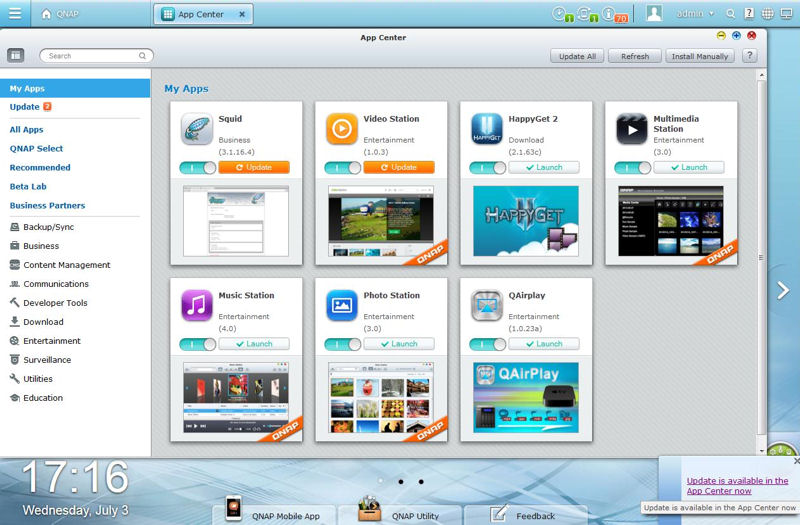
App Center showing My Apps
Qsync (Beta) – This application synchronizes data between your QNAP NAS and Windows PCs. It supports selective folder synchronization and can create download links for file sharing. Currently, there isn’t a Qsync application for the MacOS platform. You can acess your Qsync folder from within the QFile mobile applications (both iOS and Android). But you can’t synchronize your mobile devices as you would with other cloud services such as Dropbox or SugarSync.
I installed the Qsync software on both a Windows7 and an XP computer and synchronization worked as expected. With the application, you can see which Qsync devices are connected and view synchronization logs by user. Team folders are also supported.
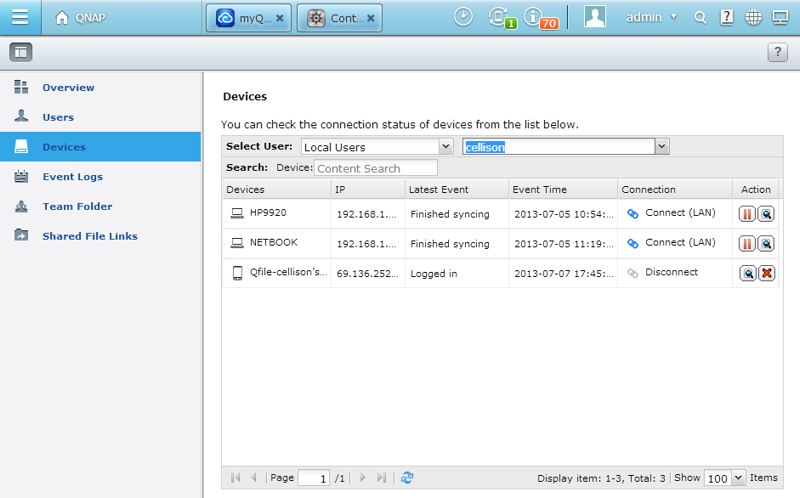 QSync Devices shows three devices for user “cellison”
QSync Devices shows three devices for user “cellison”
AirPlay (via QAirPlay app) – This allows you to stream media files to an Apple TV I don’t have an Apple TV device, so I couldn’t test this feature.
Mobile Apps
QNAP has a suite of mobile applications for both iOS and Android platforms. If you click on the QNAP Mobile App tab on the bottom of the landing screen, you’ll land at this page:
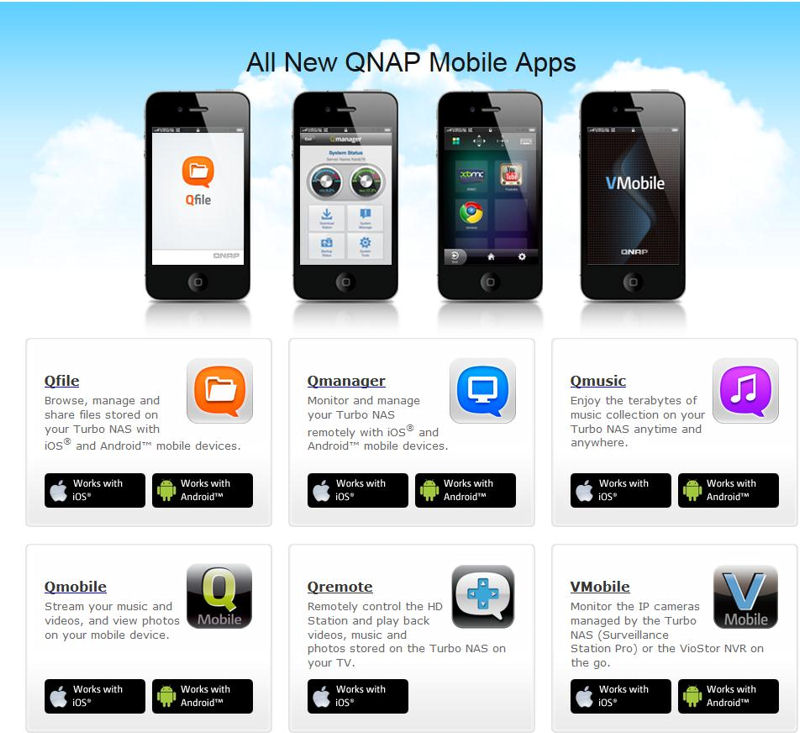
QNAP Mobile Apps
However, not all apps are available on all platforms. I went to the Google Play store as well as the Apple App store to check for application availability. All of the apps listed are available for the iPhone, but only about half of the apps have iPad-specific apps. The chart below indicates whether or not there is app support for the platform indicated.
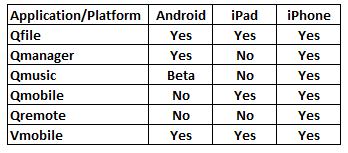
QNAP Mobile App support by platform
The gallery below illustrates features from the Qfiile, Qmanager, Qmusic and Qmobile apps. You’ll note from the screenshots that I used a mixture of platforms in the gallery.

If you click on the three horizontal lines in the upper left corner of the screen, a flyout sub menu appears.

Across the top of the screen, active tasks are shown. Here, the Music, Photo and File stations are open.

The first circle shows now background tasks running. The second show an attached drive for backups. The "i" shows the number of system notifications.

If you click on the people icon, you can change profile info (password, etc.) for the logged in user. Logged in as admin, you can also shutdown or restart the NAS.

You can search within the QNAP desktop and help

The "?" provides links to various QNAP help resources

You can change desktop modes or thumbnails. Here, I switched to detailed thumbnails. Tab mode is very handy if you don’t like resizing and moving windows.

If you click on the dashboard icon, you’ll get an overall summary of your QNAP device

Clicking on this tab at the bottom of the screen takes you to a download page of QNAP utilities that you can install on supported platforms.

This tab takes you to a page showing QNAP Mobile APPS.
Mobile Apps Gallery
Closing Thoughts
The previous version of QNAP’s OS was playing catch-up to the more fully-featured DSM4.x OS found in Synology’s latest products. But QNAP QTS 4.0 seems to have caught up and leveled the playing field with Synology.
I tested most of the applications both on a local network and a remote network on an iPad, Android Phone and a Nexus 7 tablet. For the most part, the applications were very similar. But as noted, not all of the applications were available for Android and for half of the apps, you had to use an iPhone version on your iPad. Some of the features were tagged with “beta”. Clearly, those were still in development.
CloudLink was probably the biggest disappointment. I was hoping that the “secret sauce” would actually let me connect to the QNAP device using my “myqnapcloud.com” account, but it didn’t. Admittedly, UPnP worked very smoothly and there were no hiccups setting up remote access.
Of course, some readers probably don’t keep UPnP enabled for security reasons. I suspect that those readers would also have no problems making a handful of port forwarding entries in their router. But QNAP’s reliance on port forwarding for remote access will frustrate users who must run in a double-NAT environment (such as having an ISP-mandated modem/router that can’t be bridged).
Of all of the mobile apps, probably my favorite app was Qmanager. It provided a wealth of monitoring and control capabilities. For example, when I checked the QNAP this morning from a remote location, I noted that the CPU utilization was in excess of 90%. Checking resources indicated that the transcoding process was chewing up most of the CPU.
I found that there was overlap between some of the applications. You could, for example, play music in Qfile, Qmusic and Qmobile. I would prefer one well thought-out application that does what I need to do to, i.e. manage the NAS, access files and play multimedia content seamlessly whether on the local network or a remote network.
Still, QNAP’s QTS 4.0 represents a huge step forward for QNAP. I’ll be interested in seeing how some of the features and apps work when they no longer are “beta”.
